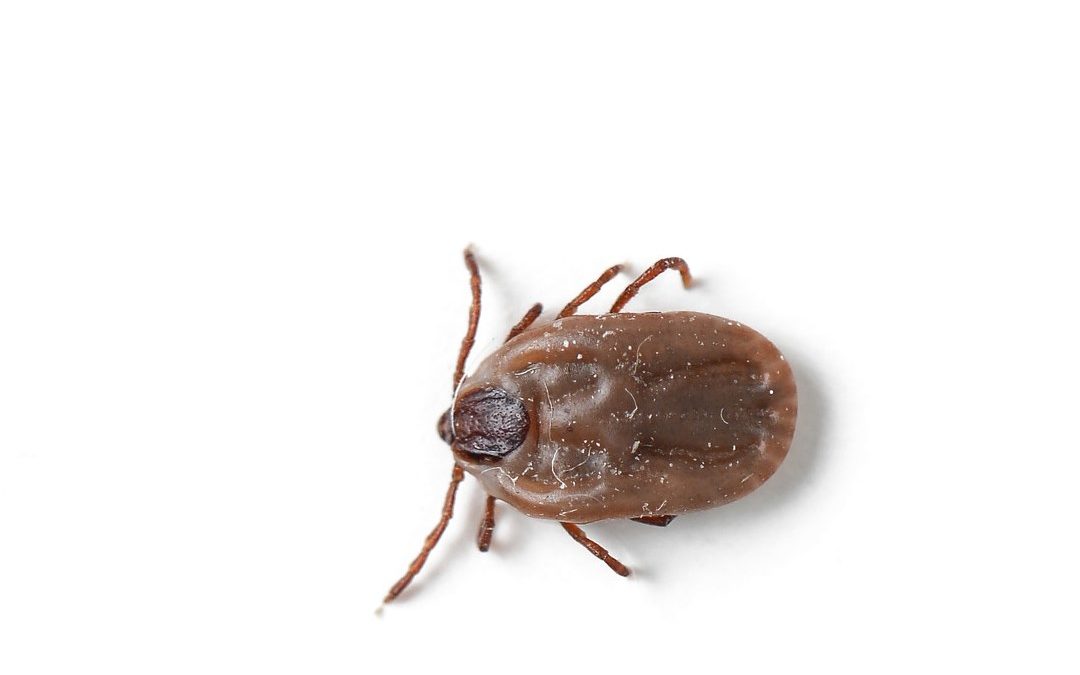Ticks are small, blood-sucking vermin, that are commonly not much larger than a sesame seed. All varieties have bodies that are oval to round. All Have six legs when young and eight legs as adults. All sizes of all types of ticks bite and feed on blood. And all have the potential to carry disease. Pest Patrol sees ticks in our area starting in April. We continue to get calls to kill them till mid-November in most years. Our treatment area has several kinds of ticks in Southeast Michigan.
The most common tick we see in our office is the American Dog Tick. As the name implies, the American Dog Tick does like the taste of dogs, but also infests cats, cows, horses, mice, rats, raccoons, opossums and frequently humans. These often are the ticks you find on the back of your neck near your hair line. Dog ticks are found in both wooded areas and in open fields. Diseases transmitted by the American Dog Tick to humans are Rocky Mountain Spotted Fever and Tularemia.
Fun Fact: American Dog Ticks mate while the female is attached to you and feeding…. then the female lays 6,000 eggs. Nice!
Deer Ticks (more properly called Blacklegged Ticks) are also very common. These guys are seen on the forest floor and along wild animal and human trails. I’ve seen these ticks on cement, asphalt, pavers and even sandy beaches.
If you watch them, you’ll see them move toward you as you scuff your feet or make some kind of disturbance. They will even follow you as you slowly back away. The young of this type of tick is translucent and very difficult to see. Deer Ticks don’t care where they attach to people. They simply attach as fast as they can. Diseases attributed to Deer Ticks are Lyme’s Disease, anaplasmosis, babesiosis, deer-tick virus, and ehrlichiosis. Deer ticks drop off their host after feeding to mate and then lay around 2,000 eggs at a time.
The Lone Star Tick is next. It gets its name not from being imported from Texas, or because it’s big (everything is bigger in Texas!), but rather because it has one poorly shaped “star” on its back; reminiscent of the Texas State flag.
I find these occasionally while in the woods and sometimes in fields, and sometime congregated in impressive numbers. Oddly enough for an insect, these strange fellows like to hang out in the shade and will feed on any kind of bird, animal or people. They are kind of the omnivores of the tick world. And because they hitch rides on birds, the birds help distribute them over wide areas. Diseases associated with Lone Star ticks include Ehrlichiosis, Rocky Mountain Spotted Fever and Tularemia.
Woodchuck Ticks. Woodchuck ticks are found on woodchucks and skunks and near the dens of woodchucks and skunks. What young lass or lad could resist poking a stick down a woodchuck hole to see what will happen? Well, they might get ticks! Woodchuck ticks will happily parasitize dogs, cats and people too. Diseases of Woodchuck Ticks? I only know of one…Powassan Encephalitis, a rare brain swelling disease of humans.
Brown Dog Ticks. Brown dog ticks will attach themselves to any color of dog, not just the brown ones. But really, although Brown dog ticks do prefer dogs, they will bit people too. Interestingly, Brown Dog Ticks are very adept in living indoors. They do very well in warm, dry weather and find our homes to be fine tick housing. Outside they live in brushy gardens up near buildings. The diseases they carried are Rocky Mountain Spotted Fever for people and then the canine varieties of ehrlichiosis, babesiosis.
Here are some tips that might help you to prevent a tick problem.
- Call Pest Patrol. Most tick problems can be solved or prevented with one or two tick treatments a year.
- Keep the brush and grass trimmed low around your home and building.
- Use Bug repellent containing DEET.
- Stay on paths when possible.
- Wear light colored clothing.
- Check yourself and your clothes for ticks after being outside.
- Check your kids and their clothes for ticks after being outside.
- Check your pets for fleas and ticks regularly.
- Remove any ticks you find quickly to reduce the chance of disease transmission.
- Control rodents in and around you home so they don’t gift you their ticks.
- Check with your doctor if you feel feverish, have a rash, or are achy or fatigued.
- Don’t let birds nest on your house.
- Don’t poke sticks down woodchuck holes!
Please get medical attention if you noticed a tick bite! Contact us to treat for ticks in other areas of your home or yard.


